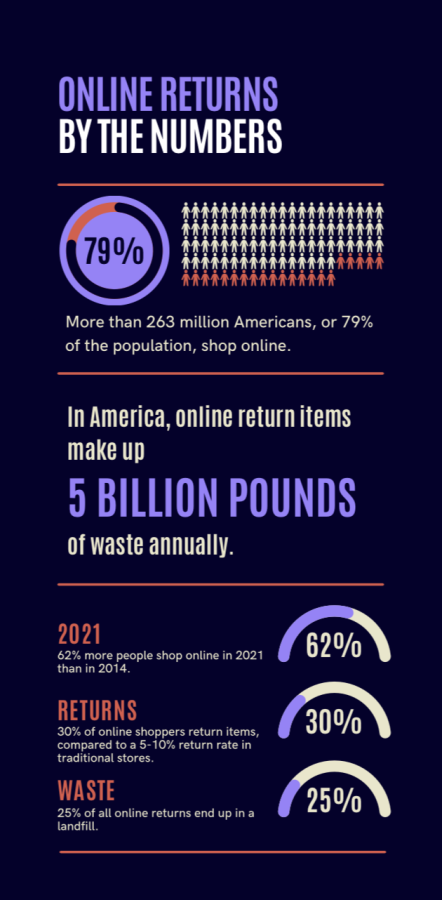Grotesque online returns overhaul requires consumer responsibility
Infographic by Anastasia Thumser ’22
Returning items online is an incredibly wasteful habit that results in 5 billion pounds of annual waste, as 25% of all online returns end up in a landfill.
With spirit week, homecoming, Halloween and early holiday shopping preceding each other at warp speed, online returns have been my crutch these past few months. If the dress with which I was once enamored is revealed to be ill-fitting or deceptively colored once it arrives at my doorstep, a simple click of a button and easy repackaging will erase my mistakes.
However, according to a CNN video, which exposed the realities of virtual shopping, I have realized that my bad habit is contributing to 5 billion pounds of annual waste from online returns in America. While changing my shopping routine may pose an inconvenience, it is my—as well as my fellow consumers’—responsibility to be more sustainable when shopping online.
Shopping via the Internet has been an option for consumers since the World Wide Web became a public domain in 1993. In the past seven years, however, the number of global online shoppers has reached an all-time high. According to Fit Small Business, 62% more people shop online in 2021 than in 2014, and more than 263 million Americans, or 79% of the population, shop online.
A significant factor compelling the majority of Americans to turn to the Internet for their shopping is the alleged ease of returns; to the consumer, it appears as though printing out a return label will ensure the product is restocked and resold.
This assumption is evident in the disparity between in-person and online shopping returns. Jason Goldberg, Chief Commerce Strategy Officer at Publicis Communications, said in the aforementioned CNN video that approximately 5-10% of shoppers at traditional brick-and-mortar stores will return items, in comparison to 30% of online shoppers.
Despite optimism from consumers that their returned product will end up in different hands, the jarring reality is that 25% of online returns end up in landfills. This is due to the fact that the process of returning items online takes up 20% more space and labor than in-store, as warehouses need to receive the product, inspect it and decide if it can be resold.
The magnitude of the waste produced by online shopping returns is a predicament that can easily be blamed on corporations.
After all, companies should be responsible for incorporating automated shopping assistants, using augmented reality and creating more accurate sizing guidelines, all of which increase the likelihood that a customer will be initially satisfied with their product. Conglomerates such as Amazon and Walmart should also shoulder the burden of adjusting their warehouse design and procedures to account for the need to process and scrutinize return items.
While large-scale companies should be held responsible for sustainability, implementing these changes to their business is a tall order that is often not cost efficient. Comparatively, consumers are in charge of their own destiny when shopping and are not expected to produce millions of dollars worth of profit. Given the freedom available to the average online shopper nowadays, individuals should be equally, if not more so, cognizant of sustainability options.
I will admit that, in the past, when hunting for the best deals on clothes or exploring the web for the perfect gift, environmental conscientiousness was not my utmost concern. This holiday season, I plan to change that by restraining my return reflex and supporting local businesses that have been lost in the limelight of the Internet, as well as making an effort to donate items I don’t want.
The pandemic has been a detriment to retail, which is an industry in danger of going bankrupt due to competition from online outlets. Not only can shopping in-person support valuable stores that are in economic decline, but it can also prevent unnecessary returns. Adding ten of the same shirts to a virtual shopping cart seems trivial, but walking out of a store with armloads of clothes physically feels excessive. Brick-and-mortar stores provide a much-needed reality check that deters the wastefulness of online returns.
Donating items to Goodwill or a local thrift shop is also a sustainable method of getting rid of unwanted clothes, especially during the holiday season when people are most in need. The benevolent act of donation is not only a heartwarming way to brighten someone’s day, but also increases the chances of an item ending up in another person’s hands, rather than in a landfill. Resisting the impulse to return an online item can potentially save a small business, or even the environment.

Web Managing Editor Anastasia Thumser ’22 grew up as a writer, though the road wasn't easy.
“I kind of got off to a rough start in the class. It...






















































